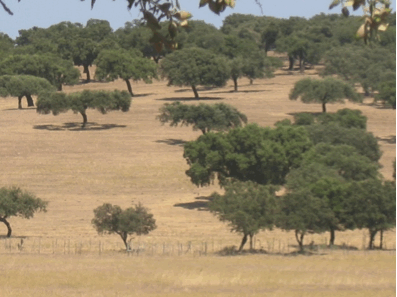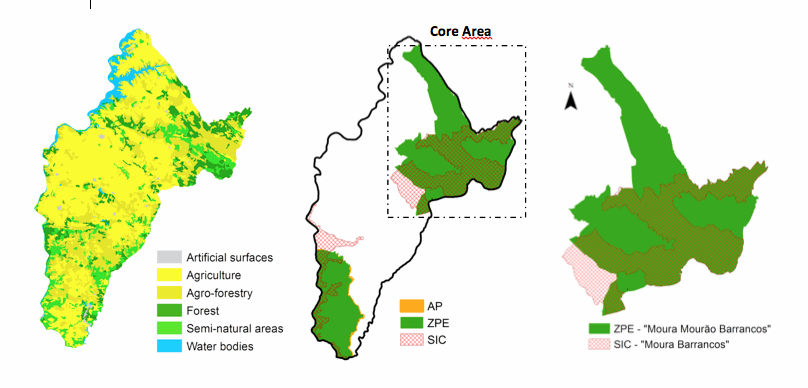Coarse Grain Case Study Summary Portugal
 The Portuguese case study will be developed at both national and local level. While the coarse-grain analysis considered the whole continental Portugal, the fine grain study will focus on a selected area in the southeast portion of the country.
The Portuguese case study will be developed at both national and local level. While the coarse-grain analysis considered the whole continental Portugal, the fine grain study will focus on a selected area in the southeast portion of the country.
Contact: Paula Antunes, CENSE
Case study location and conservation characteristics
Forest biodiversity in Portugal is mostly associated to human-shaped habitat/landscape, such as montados or cork oak (
Quercus suber) and holm oak (
Quercus rotundifolia) forests.
Montados are multifunctional systems that, besides forming a diversity of habitats of high conservation value, contribute to climate regulation, water cycle regulation, soil quality, protection against fire and provision of cork and other products. Thus, the protection of
montados is fundamental to national goals related to climate regulation, biodiversity conservation and maintenance of socio-economic activities in rural areas.
Besides agriculture and infrastructure expansion, montados are currently threatened by pine and eucalyptus monoculture, which associated to a scarce and fragmented native forest and to high frequency of fires has had high negative impacts on species diversity. Increases in land abandonment rates may also jeopardize montados, as the conservation value of this ecosystem depends on the maintenance of the shrub‐grassland matrix through human management. In addition, poor agriculture practices are increasing the spread of diseases (e.g. pathogenic fungi), and preventing montados natural regeneration with new oak trees, which threatens it sustainability in the long-run.
Current economic instruments in biodiversity conservation
In Portugal policies regarding forest/biodiversity conservation are mainly based on command-and-control instruments (e.g. the national network of protected areas, Natura 2000 Network) imposing land-use restrictions or impacting agricultural and forest management practices in some territories. For this reason, conservation costs are usually unevenly spread, with some public and private actors facing costs related to protected areas or conservation activities. Compensatory measures are required for reconciling the local costs and global benefits of biodiversity conservation. Two particular economic instruments that may fulfill this role were selected and analyzed in the coarse grain case study: Agri-environment measures (AEM), which are financial incentives designed to encourage farmers to protect the environment on their farmland – including forest and agroforest systems (specifically directed to private actors); and Ecological Fiscal Transfers (EFT), which since 2007 integrate the annual transfers from the national general budget to the municipalities in order to compensate them for land‐use restrictions imposed by protected areas (specifically directed to local public actors).
No concrete evidences of the effectiveness of these instruments were found on the national case study. The EFT effectiveness has been threatened by changes simultaneously introduced in other funds and allocation criteria in the 2007 amendments of the Local Finances Law. Crossover effects that arise as a result of the different changes, the introduction of smoothing rules to avoid drastic fluctuations and the small magnitude of the ecological component, contribute to hide the financial incentive offered to municipalities by the ecological signal. In regards to AEM, the coarse grain analysis showed evidences of low implementation due to, among other factors, unfavourable economic scenario, complex eligibility requirements, insufficient financial compensation, lack of technical support and administrative constraints.
New and potential economic instruments
The coarse grain analysis did not focus on proposing new economic instruments at a national level, but on proposing changes to the EFT scheme in order to improve their effectiveness and/or cost-efficiency. The ecological criterion considered in the EFT is based on a single indicator, the amount of Classified Areas. Therefore, aspects related to the “relevance” (e.g. representativeness) or “quality of management” of protected areas, or to the environmental benefits provided by areas outside networks for nature conservation are not taken into account. In this context, it was proposed the inclusion of new ecological indicators that could better link financial compensations to the positive externalities (e.g. ecosystem services) each municipality provides to society, and several scenarios for different magnitudes of the ecological signal were simulated. For example, scenarios for the allocation of public funds were developed considering as alternative indicator the sum of the mean provision of cultural, regulating and supporting services by each municipality.Changes will also be proposed to the AEM during the fine grain analysis. The effectiveness and efficiency of this instrument can be enhanced through the inclusion of new measures and/or target ecological features, as well as through the introduction of new criteria for the allocation of incentives (improve targeting). Lack of data at national scale hindered impact evaluation of this instrument and, consequently, the proposal of changes and scenarios in the coarse grain assessment.
Lessons from the implementation of EFT in Brazil (ICMS Ecológico) for several years (e.g. “quality” criterion in Paraná) are relevant for the analysis and proposal of changes to the Portuguese instrument. Also the simulations results on the implementation of a new EFT scheme in Germany, will be relevant namely to propose alternative ecological criteria in intergovernmental fiscal transfers. The German study suggests that both area-based and qualitative indicators should be taken into account to assess conservation responsibilities of each State, and a set of ecological indicators were presented, which can be inspiring for the Portuguese case. In regards to the AEM, it is expected that voluntary contracts designed by Finland and Norway and the Costa Rica experience can be a source of lessons for the changes that will be proposed in the Portuguese scheme.
Instrument interactions in the federal/national/state Policymix
The policy strategy for biodiversity conservation is mainly based, since the 1980’s, in command-and-control instruments, namely the establishment of ecological reserves and natural parks and the protection of endangered species and habitats. The costs arising from restrictions imposed by command-and-control policies, as well as the need to increase effectiveness, efficiency and equity of conservation policies led to the introduction of complementary economic instruments. The new policies started to recognize the central role of private and public stakeholders as land managers and proactive actors, and tried to align their interests to conservation goals. The first instruments implemented were subsidy-based (i.e. forest development subsidies, followed by the introduction of AEM), and focused on compensating local actors for conservation costs. In 2007, an ecological criterion was incorporated in intergovernmental fiscal transfers in order to compensate also local public actors (municipalities).We did not find any evidence that policymakers and policies in Portugal dealing with the application of economic instruments have been visibly influenced by experiences (e.g. PES, TDR, EFT) in other states/countries.The fine grain case study will focus on the potential of EFT, AEM, and Classified Areas (i.e. Fundamental Network for Nature Conservation, and Natura 2000 Network) to complement each other. The demarcation of protected areas is considered one of the essential regulatory instruments for biodiversity conservation in Portugal. However, it creates several restrictions to land use both for private actors (Natura 2000 does not exclude human activity, but restricts management practices) and public actors, who then have to bear the costs of conservation. EFT based on the amount and restriction level imposed by Classified Areas in each municipality can, if effectively applied, compensate public actors for the limitations imposed and increase acceptance of new and existing protected areas. Complementarily, AEM addressing local private actors within protected areas (e.g. measures oriented to landowners in within Natura 2000 sites) may compensate private actors for their conservation costs.
Local fine grain analysis – research questions and challenges
 The local case study area is located in the southeast of Portugal, in the left bank of the Guadiana River. It encompasses multifunctional landscapes, agriculture parcels, urban settlements, national protected areas and Natura 2000 sites (a Site of Community Interest and a Birds Special Protection Area). The use of traditional agro-pastoral and extensive oak woods (montados) in the region originates from the existence, in mosaic, of carrasco, broom and an important extension of perennial pastures spontaneous under-covered. In wetter areas there are also the cork oak and clumps of oak (Quercus suber).These agro‐forest areas are the habitat of species with a high protection status, such as the Iberian lynx (Lynx pardinus), the imperial eagle (Aquila heliaca) and the black vulture (Aegypusmonachus).
The local case study area is located in the southeast of Portugal, in the left bank of the Guadiana River. It encompasses multifunctional landscapes, agriculture parcels, urban settlements, national protected areas and Natura 2000 sites (a Site of Community Interest and a Birds Special Protection Area). The use of traditional agro-pastoral and extensive oak woods (montados) in the region originates from the existence, in mosaic, of carrasco, broom and an important extension of perennial pastures spontaneous under-covered. In wetter areas there are also the cork oak and clumps of oak (Quercus suber).These agro‐forest areas are the habitat of species with a high protection status, such as the Iberian lynx (Lynx pardinus), the imperial eagle (Aquila heliaca) and the black vulture (Aegypusmonachus).
Montado ecosystem
The Site of Community Interest Moura-Mourão-Barrancos and the Birds Special Protection Area Moura-Barrancos will be the core area to develop the fine grain analysis, representing around 900 km2 (30% of the total local area) .

Local case study area. A) Land use according to CORINE Land Cover 2006; B) Classified areas: AP = National Protected area; SIC= Site of Community interest; ZPE = Bird special Protection Area.
Economic instrument effectiveness
The coarse grain analysis showed that, in general, implementation of AEM has been low. Thus, the ecological effectiveness of this instrument at local level is not expected to be high. EFT are not expected to be highly effective at local level either, since the national case study showed that the criteria and algorithm adopted for the allocation of transfers end up eroding the ecological signal in play.
The fine grain assessment will focus on identifying constrains in the current design of the AEM scheme that may be preventing this instrument from achieving its full conservation potential. Improvements will be proposed in order to ensure spatial continuity of conservation actions and guarantee minimum area requirements for specific conservation goals, therefore increasing AEM ecological effectiveness.
In this stage of the fine grain analysis the Marxan software, which provides decision support to a range of conservation planning problems, will be used. Marxan was primarily designed to address a class of reserve design problems known as “the minimum set”, where the goal is to ensure a given representation of biodiversity features for the smallest possible cost. To date, Marxan has been used mostly with the purpose of helping design reserve systems. In Portugal, however, biodiversity is many times associated to ecosystems highly dependent on human management, for which reserve systems are not a suitable conservation approach. For this reason, the present work aims to use Marxan for a conservation planning task other than setting protected areas, which is optimizing the distribution of AEM that address conservation of particular human-shaped systems. The main methodological challenge for the tasks proposed is to obtain refined spatial data on the distribution of AEM and ecological features.
Economic instrument costs and benefits
Estimating costs and benefits at local level of both AEM and EFT is an important step to better assess the impact of these instruments, as well as to propose changes to increase their cost-effectiveness. In regards to the EFT, the aim of the fine grain analysis is to identify opportunity, management and transaction costs associated with PAs for municipalities, as well as how do they relate to amounts received as compensation through the EFT-LFL scheme. In addition, we will assess the effects of introducing new ecological criteria for municipalities in the case study area. For the AEM the idea is to assess the opportunity costs for local landowners and their relation with currently received compensations, as well as estimating acceptable compensation payments based on the WTP/WTA of landowners for the new proposed AEM actions/measures.The central methodological approach to carry on the tasks proposed above is conducting choice experiments with private actors (landowners), benefiting from the previous work developed for the German and Dutch cases, and cooperating with the Costa Rica team.
Economic instrument equity and legitimacy
Equity and legitimacy of the economic instruments considered were poorly assessed during the coarse grain phase due to limitation of conducting such analysis at national level. For this reason, we plan to better investigate these aspects directly with the main stakeholders for the local case study. For the EFT, we will try to assess the perceived fairness by the local public actors, and the scheme contribution to change their perceptions and attitudes towards biodiversity conservation. We also want to identify the main beneficiaries of AEM and, with these answers make proposals to improve fairness (procedural and outcome) in the scheme.Interviews and focus groups will be the methodologies employed to help estimating equity and legitimacy of EFT and AEM at local level.
Institutional opportunities and constraints for economic instruments
The coarse grain analysis showed that there are several institutional constrains undermining the effectiveness of AEM. For the local case study we want to interview local actors in order to identify the institutional factors affecting participation in AEM in the local area. With a clear idea of these factors, we plan to propose a more effective scheme by identifying target actors and management entities, as well as proposing new rules and guidelines.
Integrated Policymix assessments
Analysis of EFT and AEM effectiveness, cost efficiency and social legitimacy will be performed considering interactions between the three instruments mentioned (PA, EFT and AEM). Conclusions will be derived regarding the way instruments effectiveness can be enhanced through design changes, in light of their co-existence with other current conservation instruments.